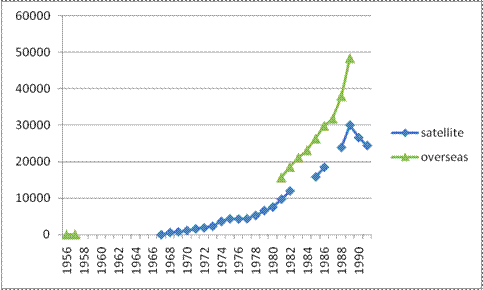 Donelan.COM
Donelan.COM
Overseas telephone communications and statistics
Several years of the Federal Communications Commission, Statistics of Communications Common Carriers were missing or damaged because the Boston Public Library had a flood affecting its Government Documents collection. If you have additional data, please let me know.
This chart shows the total number of overseas telephone and private line circuits (or circuit equivalents, which I'm going to just call circuits) via any type of transmission facility (cable, terrestrial radio, and satellite), and the number of overseas circuits via satellite in use each year via commercial communication satellites. "Overseas" are transoceanic circuits and do not include North American circuits between the USA, Canada and Mexico. This does not include telegraph circuits. Because telegraph/telex was the dominant method for overseas communications until the early 1970's, a more exhaustive analysis would attempt to normalize the changing communication methods over the years.
Between 1980 and 1988, satellite circuits were used for roughly 50% to 65% of overseas circuits from the US. An exact number would require reviewing the original data sets for variations in how overseas circuits between places like Cuba, Alaska, Hawaii, Puerto Rico and US territories were counted in different years.
The percentage of telephone circuits via satellite was probably greater during the early 1970's but I couldn't find the total number of overseas circuits reported. In the late 1960's, NASA and the US military used a substantial percentage of available commercial communications satellite capacity. Not shown on the chart, in the 1990's the percentage of fiber optic cable circuits greatly increased and percentage of satellite circuits decreased (although the number of satellite circuits increased until 2000) for telephone traffic in the 1990s. In 2006, satellite circuits were used for less than 0.2% of US international telephone and private circuits.

Sources: Statistics of Communications Common Carriers 1965-1989, Section 43.82 Circuit Status Report 1995-2006, Federal Communications Commission.
International Circuit Statistics (Excel)
Chronology of some events
- 1927
- Radio-telephony between US and Europe (2 radio channels)
- 1955
- 14 overseas radio-telephony channels in service (6 to Europe, others to South America and Asia-Pacific)
- 1956
- First trans-atlantic telephone cable (TAT-1) (29 channels to US, 6 channels to Canada, 1 telegraph channel)
- 1962
- Communications Satellite Act creates COMSAT
- 1964
- First trans-pacific cable (TPC-1) from Japan to Hawaii connected to HAW-1 from Hawaii to US Mainland
- 1965
- Early Bird satellite (150 channels)
- 1966
- First FCC rulemaking allocating overseas circuits between COMSAT satellites and transoceanic cables. Building new transoceanic cables was prohibited until carriers purchased the same number of satellite circuits. Circuits via satellite and cable were priced according to a blended cost formula.
- 1969
- INTELSAT-III completes global satellite coverage of the earth
- 1971
- FCC "proportional use" rules allocating circuit growth between satellites and cables lead to disputes between COMSAT, AT&T and European regulators. Approximately 80% of circuit growth was initially allocated by the FCC to satellites. COMSAT wanted more satellite utilization, AT&T wanted more cable utilization. FCC initiates proceedings about every 5 years changing overseas growth allocation formulas between satellite and terrestrial facilities.
- 1974
- First US domestic satellite (WESTAR I).
- 1981
- Record Carrier Competition Act eliminates distinction between domestic and overseas carriers. Note: "domestic" included connections in North America to Canada and parts of Mexico, but excluded overseas connections to Hawaii and US territories outside North America.
- 1982
- Approximately 68% of AT&T domestic long distance traffic carried by microwave radio relay. Approximately 52% of US overseas traffic carried by satellite.
- 1983
- First AT&T fiber-optic route between Washington DC and New York
- 1984
- SPRINT announces 100% fiber-optic network plans, completed in 1987
- 1987
- FCC eliminates rules allocating overseas circuit growth between satellite and cables
- 1988
- First trans-atlantic fiber optic cable (TAT-8) (40,000 circuit equivalents)
- 1989
- First private trans-atlantic fiber optic cable (PTAT-1)
- 1994
- Approximately 90% of AT&T domestic long distance network uses fiber-optic cables. In addition to existing SPRINT and MCI networks, several other competitors start building national and international fiber-optic networks.
- 1995
- Satellites carry 15% of US international circuits. The FCC changes its circuit data collection methodology, instead of domestic/overseas its now US/international.
- 1996
- Telecommunications Act of 1996
- 2000
- Satellites carry 4.6% of US international circuits. The number of US international circuits via satellite peaks at 92,716 circuit equivalents.
- 2006
- Satellites carry 0.22% of US international circuits. There are 14,346 US international circuits via satellite.